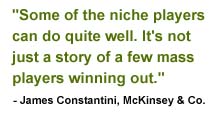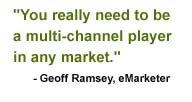|
Profiting from e-commerce
|
 |
October 12, 2000: 3:41 p.m. ET
It is possible to sell profitably online; it helps to have other sales channels
|
NEW YORK (CNNfn) - It is possible to make money selling products on the Internet, but it helps a lot if you also have other sales channels, new research shows.
"Winning e-businesses can be highly profitable," with operating margins above 15 percent, said Jason Walsh of the consulting firm McKinsey & Co.
Obviously, however, most aren't. Even category leaders such as Amazon.com (AMZN: Research, Estimates) have had difficulty showing a profit, although market watchers believe it is possible.
 Walsh acknowledged that the online merchants remain "well under water as a whole." But McKinsey's findings, based on a growing benchmarking program that now involves some 200 e-commerce companies, shows "a wide dispersion between the worst performers and the best performers." Walsh acknowledged that the online merchants remain "well under water as a whole." But McKinsey's findings, based on a growing benchmarking program that now involves some 200 e-commerce companies, shows "a wide dispersion between the worst performers and the best performers."
The secret? "It's not a brilliant business vision. It tends to be rooted in operational excellence," Walsh told participants Wednesday at the "Silicon Alley Venture Capital Summit," a conference organized by the Silicon Alley Reporter trade magazine.
Old-fashioned business values
That means old-fashioned business values such as keeping costs under control, providing strong customer service and getting the right products to the customer in a timely way.
It does not mean that mega-merchants will steamroll smaller competitors in the e-commerce game.
 "Some of the niche players can do quite well," said James Constantini, who participated with Walsh in the McKinsey presentation. "It's not just a story of a few mass players winning out." "Some of the niche players can do quite well," said James Constantini, who participated with Walsh in the McKinsey presentation. "It's not just a story of a few mass players winning out."
Nor are Super Bowl ads the answer. The key, Constantini said, lies in "how that money is spent rather than how much." Some of the most successful e-tailers employ "highly focused marketing communications to tightly defined markets."
In that connection, the big, high-profile campaigns can backfire on newcomers, draining the marketing budget with a few large, expensive ad buys, while the reality of brand building calls for a consistent, progressive presence in the marketplace, involving repeated impressions on the target market.
Selling through other channels
It is expensive to build a brand on the Internet, and it turns out that one of the key "e-performance metrics" is a company's success in other sales channels. An online merchant with a second channel -- such as a catalog operation or brick-and-mortar store -- is likely to convert Web site visitors to buyers at the rate of 3-1/2 percent, versus 2 percent for a pure-play e-tailer, the McKinsey research shows..
Having a third channel seems to give a merchant another bump in that online "conversion rate," Constantini said.
To look at that another way, consider the case of Eddie Bauer, the sportswear company. According to eMarketer, an aggregator of Internet statistics, shoppers who use the company's Web site alone spend on average $100 a year. Those who also browse the company's catalog spend $300 to $500 annually, and those who also shop in Eddie Bauer retail stores spend $1,000 or more with the company overall, through the three channels, according to Geoff Ramsey, the Web consultant's "statmaster."
"You really need to be a multi-channel player in any market," he added.
In fact, existing real world businesses -- especially catalog retailers -- may have a key advantage over pure-play Internet startups precisely because they already have made the investment in inventories, in brand development and in delivery systems that will enable them to make the most of their investments online, Ramsey said.
Still, he emphasized, customer service takes on growing importance when the competition is only a click away. It takes 2-1/2 years for an Amazon customer to become profitable to the company, Ramsey said: "It's time to start emphasizing nurture over capture." 
|
|
|
|
|
 |

|

